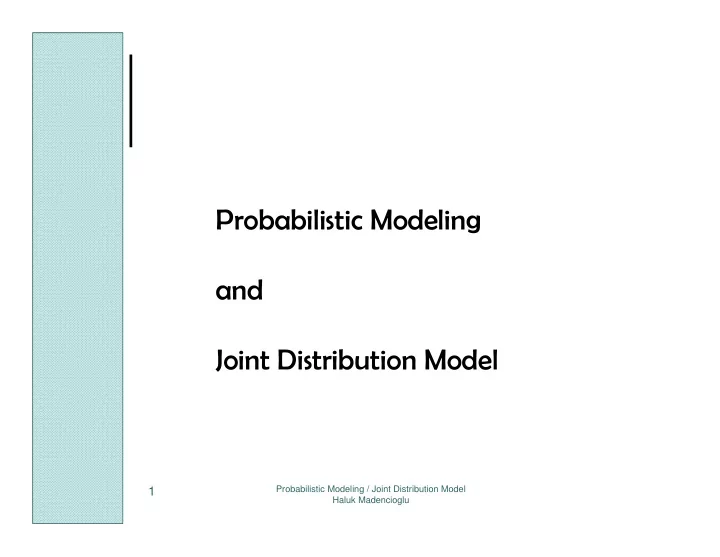

Probabilistic�Modeling� and� Joint�Distribution�Model Probabilistic Modeling / Joint Distribution Model 1 Haluk Madencioglu
Elements�of�Probability�Theory Introduction � Concerned�with�analysis�of�random�phenomena � Originated�from�gambling�&�games � Uses�ideas�of�counting,�combinatorics�and�measure� theory � Uses�mathematical�abstractions�of�non!deterministic� events� Probabilistic Modeling / Joint Distribution Model 2 Haluk Madencioglu
Elements�of�Probability�Theory Introduction � Continuous�probability�theory�deals�with�events�that� occur�in�a�continuous�sample�space � Discrete�probability�deals�with�events�that�occur�in� countable�sample�spaces � Events�:�a�set�of�outcomes�of�an�experiment � Events�:�a�subset�of�sample�space Probabilistic Modeling / Joint Distribution Model 3 Haluk Madencioglu
Elements�of�Probability�Theory Axioms�of�Probability � Nonnegativity :� 0 ≤ P(E) ≤ 1 = ∑ � Additivity :� P E ( , E ..., E ) P E ( ) 1 2 n i i � Normalization�(unit�measure):� P( Ω ) =1, P( ∅ )=0 � Some�consequences: � P( Ω \ E) = 1-P(E) { Ω : universe} � P(A U B) = P(A) + P(B) – P(A ∩ B) � P(A \ B) = P(A) – P(B) if B ⊆ A Probabilistic Modeling / Joint Distribution Model 4 Haluk Madencioglu
Elements�of�Probability�Theory Conditional�probability� � Bayes Rule�: P(A|B) =P(A,B) / P(B) � OR�: � P(A|B) =P(B|A).P(A) / P(B) � Independency�condition�:� P(A,B) = P(A).P(B) � Mutually�exclusive�events�:� P(A,B) = 0 � Mutually�exclusive�events�:� P(A U B) = P(A) + P(B) � OR � P(A \ B) = P(A) Probabilistic Modeling / Joint Distribution Model 5 Haluk Madencioglu
Elements�of�Probability�Theory Random�Variables � A�variable � A�function�mapping�the�sample�space�of�a�random� process�to�the�values � Values�can�be�discrete�or�continuous � Each�outcome�as�value�(or�a�range)�is�assigned�a� probability Probabilistic Modeling / Joint Distribution Model 6 Haluk Madencioglu
Elements�of�Probability�Theory Random�Variables � A�variable � A�function�mapping�the�sample�space�of�a�random� process�to�the�values � Values�can�be�discrete�or�continuous � Discrete�example�:�fair�coin�toss� � X= { 1�if�heads,�0�if�tails } � Or�fair�dice�roll�:�X= { “ the�number�shown�on�dice ” } Probabilistic Modeling / Joint Distribution Model 7 Haluk Madencioglu
Elements�of�Probability�Theory Random�Variables � Continuous�example:�spinner � Outcome�can�be�any�real�number�in [0,2 π ) � Any�specific�value�has�zero�probability � So�we�use�ranges�instead�of�single�points � E.g.�having�a�value�in�[ 0 , π /2 ] has�probability 1/4 Probabilistic Modeling / Joint Distribution Model 8 Haluk Madencioglu
Elements�of�Probability�Theory Random�Variables � In�case�of�discrete�random�variables�we�use� probability�mass�function = { 1/2 if X=0, 1/2 if X=1, 0 otherwise } P ( ) x � X � Notice�the�use�of�uppercase�for�the�random�variable� and�lowercase�for�the�mass�function�variable � Cumulative�distribution�function�(CDF)�: = ≤ F ( ) x P X ( x ) X Probabilistic Modeling / Joint Distribution Model 9 Haluk Madencioglu
Elements�of�Probability�Theory Random�Variables � In�case�of�continuous�variables , � We�use�a�probability�density�function� b = ∫ ≤ ≤ P [ a X b ] p x dx ( ) X a � So�that�the�CDF�becomes x = ∫ F ( ) x p u du ( ) X −∞ Probabilistic Modeling / Joint Distribution Model 10 Haluk Madencioglu
Elements�of�Probability�Theory Well�Known�Distributions � Discrete�uniform�distribution� Probabilistic Modeling / Joint Distribution Model 11 Haluk Madencioglu
Elements�of�Probability�Theory Well�Known�Distributions � Binomial�distribution � Special�case�:�n=1�!>�Bernoulli�distribution Probabilistic Modeling / Joint Distribution Model 12 Haluk Madencioglu
Elements�of�Probability�Theory Well�Known�Distributions � Special�case�:�n=1�!>�Bernoulli�distribution Probabilistic Modeling / Joint Distribution Model 13 Haluk Madencioglu
Elements�of�Probability�Theory Well�Known�Distributions � Poisson�distribution�:�n�events�occur�with�a�known� average�rate� λ λ and�independently�of�the�time�since� λ λ the�last�event Probabilistic Modeling / Joint Distribution Model 14 Haluk Madencioglu
Elements�of�Probability�Theory Expected�Value�and�Variance � Expected�value�:�A�measure�of�probability�weighted� average�of�expected�outcomes � Variance�:�expected�value�of�the�square�of�the� deviation�of�random�variable�from�its�expected�value Probabilistic Modeling / Joint Distribution Model 15 Haluk Madencioglu
Elements�of�Probability�Theory Joint�Distributions � More�than�one�random�variable � On�the�same�probability�space�(universe) � Events�defined�in�terms�of�all�variables � Called�multivariate�distribution� � Called�bivariate if�two�variables�involved � Remembering�Bayes rule,�conditional�distribution: Probabilistic Modeling / Joint Distribution Model 16 Haluk Madencioglu
Probabilistic�Modeling Joint�Distributions � Similar�to�probabilities,�if�variables�are�independent: � Continuous�distribution�case: � Marginal�distributions: � Reduces�to�simple�product�summation�if�independent Probabilistic Modeling / Joint Distribution Model 17 Haluk Madencioglu
Probabilistic�Modeling Random�Configurations � In�general�a�set�of�n�random�variables: = V ( , V V ..., V ) 1 2 n � With�possible�outcomes�for�each�variable: { , x x ..., x } 1 2 m � A�configuration�is�a�vector�of�x�where�each�value�is� assigned�to�a�variable = x ( , x x ..., x ) 1 2 n CSCI�6509�Notes�Fall�2009 Faculty�of�Computer�Science�Dalhousie�University Probabilistic Modeling / Joint Distribution Model 18 Haluk Madencioglu
Probabilistic�Modeling Random�Configurations � In�modeling�we�assume�a�sequence�of�configurations: (1) ( ) t x ,..., x (1) = x ( x , x ,... x ) 11 12 1 n (2) = x ( x , x ,... x ) 21 22 2 n ( ) t = x ( x , x ,... x ) t 1 t 2 tn Here�we�assume�a�fixed�number�(n)�of�components�in�each� � configuration,�and������are�values�from�finite�set� x ij Probabilistic Modeling / Joint Distribution Model 19 Haluk Madencioglu
Probabilistic�Modeling Random�Configurations � NLP�uses�probabilistic�modeling�as�a�framework�for� solving�problems � Computational�tasks: � Representation�of�models � Simulation�:�generating�random�configurations � Evaluation�:�computing�probability�of�a�complete�configuration � Marginalization�:�computing�probability�of�a�partial�configuration � Conditioning�:�computing�conditional�probability�of�completion� given�partial�observation � Completion�:�find�most�probable�completion�of�partial�observation � Learning�:�parameter�estimation Probabilistic Modeling / Joint Distribution Model 20 Haluk Madencioglu
Probabilistic�Modeling Joint�distribution�model � A�joint�probability�distribution� = = = P X ( x X , x ,.... X x ) 1 1 2 2 n n specifies�the�probability�of�each�complete� configuration� � In�general�it�takes�m�x�n�parameters�(less�one� constraint)�to�specify�an�arbitrary�joint�distribution�on� n�random�variables�with�m�values Probabilistic Modeling / Joint Distribution Model 21 Haluk Madencioglu
Probabilistic�Modeling Joint�distribution�model θ θ θ , ,... � This�can�be�captured�in�lookup�table (1) (1) n x x ( V ) x where����������gives�the�probability�of�RV’s�taking�on������ θ ( ) k x jointly��the�configuration ( ) k x ( ) k � So θ = = P X ( x ) ( ) k x V ∑ � Satisfying��� θ = 1 ( k ) x = k 1 Probabilistic Modeling / Joint Distribution Model 22 Haluk Madencioglu
Recommend
More recommend